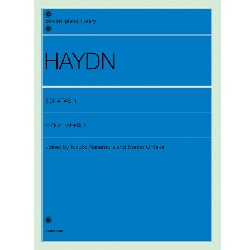Haydn, Franz Joseph : Sonate für Klavier Nr.52 G-Dur Hob.XVI:39 op.30-5
Work Overview
Publication Year:1780
First Publisher:Artaria
Instrumentation:Piano Solo
Genre:sonata
Total Playing Time:13 min 30 sec
Copyright:Public Domain
Additional Notes:第52番は「ウィーン原典版」の番号
Commentary (1)
Author : Saitoh, Noriko
Last Updated: August 1, 2007
[Open]
Author : Saitoh, Noriko
Composed between 1779 and 1780. It consists of three movements.
First Movement
The first movement, in G major, is in 2/4 time with an Allegro con brio tempo. This movement is written in rondo form, not sonata form. The rondo theme is based on a descending melodic figure from the third scale degree to the tonic, and then from the sixth scale degree to the tonic. When it reappears, the initial four measures are re-presented once, and then repeated with rhythmic variations.
Second Movement
The second movement, Adagio, is in 3/4 time and in C major, the subdominant key of the first movement. In this 3/4 meter, the third beat often moves towards the first beat of the next measure. It is written in three-part form, with the third part expanding or varying the melodic figures of the first part. While the secondary theme of the first part is in G major, the secondary theme of the third part is in the tonic C major, suggesting that the tonal scheme, in a sense, adheres to the normative structure of sonata form. This is interesting, considering that the first movement of this piano sonata was not written in sonata form.
Third Movement
The third movement, Prestissimo, is in 6/8 time and in G major, the same key as the first movement. This movement is written in sonata form. The opening theme is accompanied by the left hand in thirds or octaves, playing a line interspersed with octaves. The second theme develops by swapping the roles of the left and right hands from the first theme. Because the first and second themes of this sonata movement are similar in nature, neither theme predominates in the development section (from m. 44). However, near the end of this development section, the first theme is pseudo-recapitulated in G minor, its parallel minor. Therefore, although this sonata movement does not feature a strong contrast between the first and second themes, it does not end up monotonous. In the recapitulation (from m. 79), the exposition is faithfully reproduced through transposition.
Movements (3)
PTNA & Partner Channel Videos(0items)
Reference Videos & Audition Selections(3items)
Sheet Music
Scores List (11)

(株)全音楽譜出版社

ヘンレー

(株)音楽之友社

ヘンレー

ヘンレー

ヘンレ社(ヤマハ)

ヘンレー

(株)音楽之友社






